
A galaxy is a system of stars, stellar remnants, interstellar gas, dust, and dark matter bound together by gravity. The word is derived from the Greek galaxias (γαλαξίας), literally 'milky', a reference to the Milky Way galaxy that contains the Solar System. Galaxies, averaging an estimated 100 million stars, range in size from dwarfs with less than a thousand stars, to the largest galaxies known – supergiants with one hundred trillion stars, each orbiting its galaxy's center of mass. Most of the mass in a typical galaxy is in the form of dark matter, with only a few percent of that mass visible in the form of stars and nebulae. Supermassive black holes are a common feature at the centres of galaxies.

Virgo is one of the constellations of the zodiac. Its name is Latin for maiden, and its old astronomical symbol is . Between Leo to the west and Libra to the east, it is the second-largest constellation in the sky and the largest constellation in the zodiac. The ecliptic intersects the celestial equator within this constellation and Pisces. Underlying these technical two definitions, the sun passes directly overhead of the equator, within this constellation, at the September equinox. Virgo can be easily found through its brightest star, Spica.

The Hubble sequence is a morphological classification scheme for galaxies published by Edwin Hubble in 1926. It is often colloquially known as the Hubble tuning-fork diagram because the shape in which it is traditionally represented resembles a tuning fork. It was invented by John Henry Reynolds and Sir James Jeans.

A lenticular galaxy is a type of galaxy intermediate between an elliptical and a spiral galaxy in galaxy morphological classification schemes. It contains a large-scale disc but does not have large-scale spiral arms. Lenticular galaxies are disc galaxies that have used up or lost most of their interstellar matter and therefore have very little ongoing star formation. They may, however, retain significant dust in their disks. As a result, they consist mainly of aging stars. Despite the morphological differences, lenticular and elliptical galaxies share common properties like spectral features and scaling relations. Both can be considered early-type galaxies that are passively evolving, at least in the local part of the Universe. Connecting the E galaxies with the S0 galaxies are the ES galaxies with intermediate-scale discs.

Centaurus A is a galaxy in the constellation of Centaurus. It was discovered in 1826 by Scottish astronomer James Dunlop from his home in Parramatta, in New South Wales, Australia. There is considerable debate in the literature regarding the galaxy's fundamental properties such as its Hubble type and distance. NGC 5128 is one of the closest radio galaxies to Earth, so its active galactic nucleus has been extensively studied by professional astronomers. The galaxy is also the fifth-brightest in the sky, making it an ideal amateur astronomy target. It is only visible from the southern hemisphere and low northern latitudes.

Galaxy morphological classification is a system used by astronomers to divide galaxies into groups based on their visual appearance. There are several schemes in use by which galaxies can be classified according to their morphologies, the most famous being the Hubble sequence, devised by Edwin Hubble and later expanded by Gérard de Vaucouleurs and Allan Sandage. However, galaxy classification and morphology are now largely done using computational methods and physical morphology.
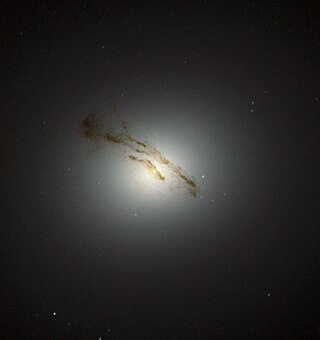
Messier 84 or M84, also known as NGC 4374, is a giant elliptical or lenticular galaxy in the constellation Virgo. Charles Messier discovered the object in 1781 in a systematic search for "nebulous objects" in the night sky. It is the 84th object in the Messier Catalogue and in the heavily populated core of the Virgo Cluster of galaxies, part of the local supercluster.

NGC 3115 is a field lenticular (S0) galaxy in the constellation Sextans. The galaxy was discovered by William Herschel on February 22, 1787. At about 32 million light-years away from Earth, it is several times bigger than the Milky Way. It is a lenticular (S0) galaxy because it contains a disk and a central bulge of stars, but without a detectable spiral pattern. NGC 3115 is seen almost exactly edge-on, but was nevertheless mis-classified as elliptical. There is some speculation that NGC 3115, in its youth, was a quasar.

NGC 1097 is a barred spiral galaxy about 45 million light years away in the constellation Fornax. It was discovered by William Herschel on 9 October 1790. It is a severely interacting galaxy with obvious tidal debris and distortions caused by interaction with the companion galaxy NGC 1097A.

NGC 1316 is a lenticular galaxy about 60 million light-years away in the constellation Fornax. It is a radio galaxy and at 1400 MHz is the fourth-brightest radio source in the sky.
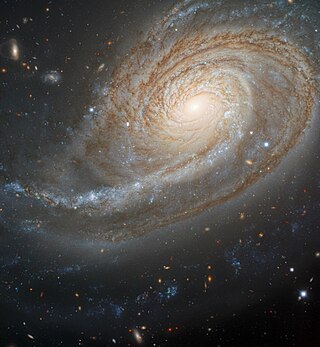
NGC 772 is an unbarred spiral galaxy approximately 130 million light-years away in the constellation Aries.

NGC 1553 is a prototypical lenticular galaxy in the constellation Dorado. It is the second brightest member of the Dorado Group of galaxies. British astronomer John Herschel discovered NGC 1553 on December 5, 1834 using an 18.7 inch reflector.

NGC 4452 is an edge-on lenticular galaxy that is part of the Virgo Cluster. NGC 4452 is about 60 million light-years (18 Mpc) away from Earth and 35 kly (11 kpc) in diameter. This galaxy was first seen by William Herschel in 1784 with his 47 cm (19 in) telescope.
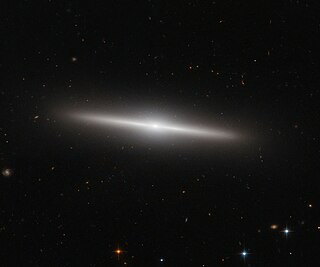
IC 335 is an edge-on lenticular galaxy about 60 million light years away, in the constellation Fornax. It is part of the Fornax Cluster.
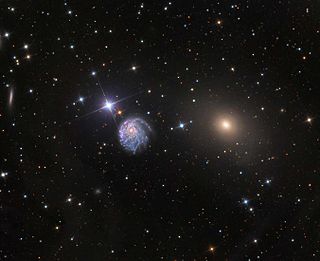
NGC 2276 is an intermediate spiral galaxy in the constellation Cepheus. The galaxy lies 120 million light-years away from Earth. NGC 2276 has an asymmetrical appearance, most likely caused by gravitational interactions with its neighbor, elliptical galaxy NGC 2300. One of the many starburst spiral arms contains an intermediate mass black hole with 50,000 times the mass of the Sun, named NGC 2276-3c. NGC 2276-3c has produced two jets: a large-scale radio jet, approximately 2,000 light years long, and an "inner jet" about 6 light years long. The galaxy shows an enhanced rate of star formation that may have been triggered by a collision with a dwarf galaxy, or by the gravitational interaction with its neighbor compressing gas and dust.

NGC 174 is a barred spiral or lenticular galaxy around 159 million light-years away in the constellation Sculptor. It was discovered on 27 September 1834 by astronomer John Herschel.
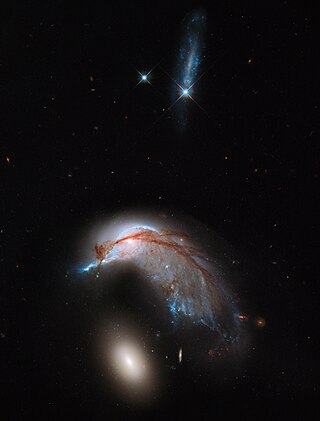
NGC 2936 is an interacting spiral galaxy located at a distance of 326 million light years, in the constellation Hydra. NGC 2936 is interacting with elliptical galaxy NGC 2937, located just beneath it. They were both discovered by Albert Marth on Mar 3, 1864. To some astronomers, the galaxy looks like a penguin or a porpoise. NGC 2936, NGC 2937, and PGC 1237172 are included in the Atlas of Peculiar Galaxies as Arp 142 in the category "Galaxy triplet".
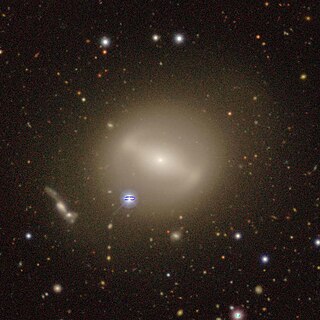
NGC 1460 is a barred lenticular galaxy in the constellation Eridanus. It was discovered by John Herschel on November 28, 1837. It is moving away from the Milky Way at 1341 km/s.

NGC 2293 is a lenticular galaxy located in the constellation Canis Major. It is located at a distance of circa 100 million light years from Earth, which, given its apparent dimensions, means that NGC 2293 is about 160,000 light years across. It was discovered by John Herschel on January 20, 1835. NGC 2293 forms a pair with NGC 2292 and has an HI ring that surrounds both galaxies.

NGC 6600 is a lenticular galaxy roughly 310 million light-years away in the constellation Hercules. NGC 6600 was discovered in 1864 by Albert Marth. Unlike our own Milky Way, NGC 6600 boasts a tightly wound structure, swirling with stars and gas.



















